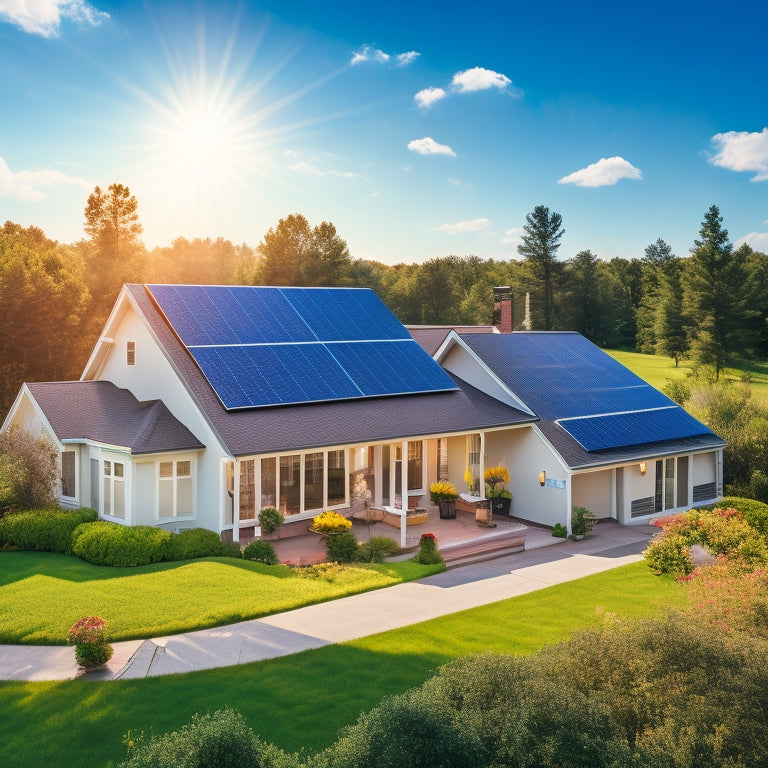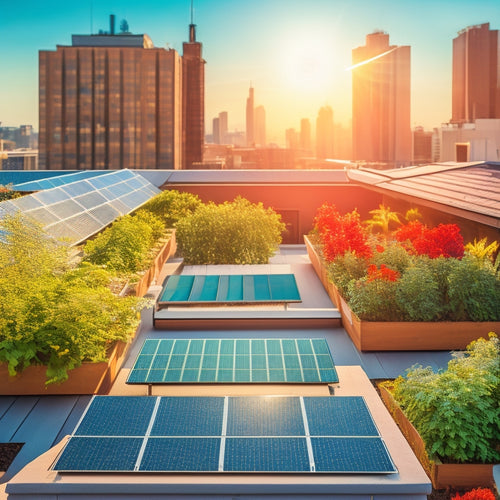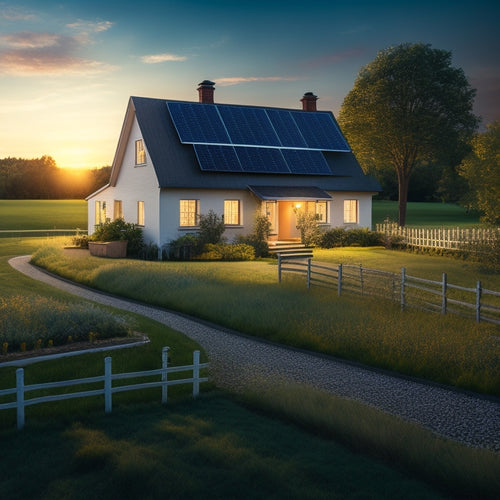
Average Solar Panel Installation Costs for Beginners
Share
You can expect to pay between $15,000 and $30,000 or more for a solar panel installation, depending on the system size and quality, which will greatly impact your long-term energy savings and return on investment. Several factors, including your energy goals, location, and roof size, will influence the overall cost. While higher-efficiency panels and larger systems may cost more upfront, they can lead to greater energy output and savings. As you maneuver through the process, understanding the average costs and breakdown of installation expenses, including labor, equipment, and permits, will help you make an informed decision about going solar - and there's more to learn about optimizing your investment.
Key Takeaways
- Total solar panel installation costs range from $15,000 to $30,000 or more, depending on system size and quality.
- System size, location, local regulations, roof size, and complexity, and shading analysis are key factors influencing installation prices.
- Installation labor costs average between $2,000 to $5,000, with labor costs per watt ranging from $0.50 to $1.50.
- Permitting and inspection costs, including electrical and building permits, can add $1,000 to $2,000 to the total installation cost.
- Financial incentives like tax exemptions, renewable energy credits, local rebates, and sales tax exemptions can help offset upfront installation costs.
Understanding Solar Panel Costs
When contemplating solar panel installation, one of the primary factors to evaluate is the cost. As you examine your options, you'll want to understand the various expenses involved.
The total cost of solar panel installation includes the upfront installation cost, which can range from $15,000 to $30,000 or more, depending on the system size and quality. However, you can offset this cost through solar financing options, such as loans or power purchase agreements.
In addition to the initial investment, you'll also want to reflect on the long-term energy savings. With solar panels, you can greatly reduce your electricity bills, potentially saving hundreds or even thousands of dollars per year.
Over time, these energy savings can help you recoup your initial investment and enjoy a strong return on investment. By understanding the costs and benefits of solar panel installation, you can make an informed decision about whether this renewable energy source is right for you.
Factors Affecting Installation Prices
You'll find that the cost of solar panel installation varies considerably depending on your specific needs and circumstances.
The system requirements you need to meet your energy goals, for instance, will impact the type and number of panels you need, which in turn affects the overall cost.
Additionally, your location and climate will influence the installation process, with factors like rooftop size, shading, and local building codes all playing a role in determining the final price.
System Requirements
By the time you're ready to install solar panels, you've likely considered factors like your energy needs and budget. Now, it's crucial to understand the system requirements that affect installation prices. The system capacity, measured in watts (W), is a critical factor. It determines how much energy your solar panel system can produce. Energy efficiency, expressed as a percentage, indicates how well your system converts sunlight into electricity.
Here's a breakdown of system requirements and their impact on installation costs:
| System Capacity (W) | Energy Efficiency (%) | Installation Cost Range |
|---|---|---|
| 2,000-5,000 | 15-18 | $3,000-$7,000 |
| 5,000-10,000 | 18-20 | $7,000-$14,000 |
| 10,000-15,000 | 20-22 | $14,000-$21,000 |
| 15,000-20,000 | 22-25 | $21,000-$28,000 |
| 20,000+ | 25+ | $28,000+ |
Keep in mind that these estimates are approximate and may vary depending on other factors. As you can see, increasing system capacity and energy efficiency generally lead to higher installation costs. However, they also result in more significant energy savings over time.
Location and Climate
Your solar panel system's location and climate play a significant role in determining installation costs. The amount of sun exposure your location receives affects your system's energy efficiency. If you live in a region with high sun exposure, you'll require fewer panels to generate the same amount of energy, reducing installation costs.
Climate zone also impacts costs, as regions with extreme weather patterns require more durable and weather-resistant equipment.
Roof orientation is another vital factor, as an ideal orientation can increase your system's energy output. Local regulations, such as permits and inspections, vary by region and can add to overall costs.
A shading analysis is also necessary to determine the impact of surrounding structures or trees on your system's performance. Weather patterns, like high winds or heavy snowfall, may require additional hardware or installation methods, increasing costs.
Understanding your location's solar potential is imperative in determining the best system size and configuration, which directly affects installation costs. By considering these location and climate factors, you can guarantee an efficient and cost-effective solar panel installation.
Average Cost of Solar Panels
You're likely wondering what the average cost of solar panels is.
System size matters, as a larger system will generally cost more, but provide more energy.
The quality of the panels themselves also impacts the overall cost, with higher-efficiency panels typically coming at a premium.
System Size Matters
As the primary determinant of solar panel installation costs, system size plays a critical role in calculating the overall expense of utilizing renewable energy. You'll need to determine your system capacity based on your energy needs, factoring in elements like panel efficiency and your budget considerations. A larger system will generally provide more power, but it'll also increase your upfront costs.
When deciding on a system size, reflect on your long-term savings and the environmental impact you want to make. A bigger system may lead to greater savings on your electricity bills, but it may also require more maintenance costs.
You'll need to weigh these elements against your budget and financing options. If you're looking to maximize your returns, you may want to reflect on a larger system. However, if you're on a tighter budget, a smaller system may be more feasible.
Ultimately, the right system size for you'll depend on your unique energy needs and financial situation. By carefully evaluating these factors, you can make an informed decision that meets your energy goals while staying within your budget.
Panel Quality Impacts
Since the dawn of solar energy, panel quality has been an essential factor in determining the overall efficiency and cost-effectiveness of a solar panel installation. You'll want to evaluate factors like panel warranties, efficiency ratings, material durability, and brand reputation when selecting the right panels for your system.
Here's a breakdown of how different panel quality factors can impact your installation costs:
| Panel Quality Factor | Impact on Installation Costs |
|---|---|
| Efficiency Ratings | Higher efficiency ratings result in more expensive panels, but can lead to lower overall system costs due to increased energy production. |
| Material Durability | More durable materials can increase upfront costs, but reduce maintenance requirements and extend the system's lifespan. |
| Brand Reputation | Reputable brands often charge more for their panels, but offer better performance guarantees and longer warranties. |
| Technology Types | Advanced technology types, such as bifacial panels, can be more expensive, but provide higher energy yields and improved system performance. |
Installation Labor Costs Breakdown
Behind every successful solar panel installation lies a team of skilled professionals, and their labor costs are a significant component of the overall project expense. As you plan your solar panel installation, it's crucial to understand the installation labor costs breakdown. You'll want to know how much you'll pay for the proficiency and time of the installation team.
The installation labor cost typically accounts for around 10% to 20% of the total project cost. This includes the cost of hiring licensed electricians, roofers, and other specialists who'll install your solar panels.
In a cost comparison, the installation labor cost can vary depending on the complexity of the installation, the location, and the installer's reputation.
On average, you can expect to pay between $2,000 and $5,000 for installation labor costs, depending on the size of your solar panel system. For a typical residential solar panel installation, the labor cost per watt can range from $0.50 to $1.50.
Keep in mind that these costs may vary depending on your specific installation requirements and the installer you choose.
Roof Size and Complexity Matters
When you're planning your solar panel installation, one essential factor to bear in mind is the size and complexity of your roof. A larger roof means more space for solar panels, but it also increases the installation cost.
Additionally, a complex roof with multiple levels, skylights, or vents requires more labor and materials, driving up costs.
You'll need to evaluate your roof's orientation, as a south-facing roof receives the most sunlight and is ideal for solar panels. If your roof doesn't face south, don't worry – solar panels can still generate significant power, but you may need more of them.
A shading analysis will also help determine the best placement for your panels, considering obstructions like trees or neighboring buildings.
Keep in mind that a roof with multiple angles or curves may require more specialized equipment and labor, increasing costs.
Your solar panel installer will assess your roof's unique characteristics and provide a customized quote based on its size and complexity.
Inverters and Mounting Hardware
Every solar panel system requires an essential component: an inverter. This device converts DC power from your solar panels into AC power, making it usable in your home.
You'll need to choose from three inverter types: string inverters, microinverters, and power optimizers. String inverters are the most common, connecting multiple panels in a series. Microinverters, on the other hand, are installed under each panel, providing more flexibility and monitoring capabilities. Power optimizers combine the benefits of both, offering panel-level monitoring and optimization.
When it comes to mounting your solar panels, you have several options. You can choose from roof-mounted, ground-mounted, or tracking systems.
Roof-mounted systems are the most common, with panels attached directly to your roof. Ground-mounted systems, on the other hand, are installed on the ground, providing more flexibility regarding placement and angle. Tracking systems allow your panels to move with the sun, maximizing energy production.
Your mounting hardware will depend on your roof type, size, and local building codes. Be sure to take into account these factors when selecting your inverter and mounting options.
Permits and Inspections Fees
Now that you've selected your inverter and mounting options, it's time to evaluate the permits and inspections required to confirm your solar panel system meets local building codes and safety standards.
The permits and inspections process can vary depending on your location, but there are some common permit types and inspection requirements you should be aware of. Here's a breakdown of the typical costs and requirements:
| Permit Type | Average Cost | Inspection Requirement |
|---|---|---|
| Electrical Permit | $100-$300 | Verify electrical connections and wiring |
| Building Permit | $500-$1,000 | Inspect the mounting system and structural integrity |
| Zoning Permit | $200-$500 | ascertain compliance with local zoning laws |
| Inspection Fee | $100-$300 | Verify system meets safety standards |
| Plan Review Fee | $100-$500 | Review system design and plans |
Keep in mind that these costs are estimates, and the actual fees may vary depending on your location and local authorities. It's crucial to factor these costs into your overall budget to confirm a smooth installation process.
Local and State Incentives
Since investing in a solar panel system can be costly, you'll want to take advantage of local and state incentives that can help offset the expenses.
These incentives can greatly reduce the upfront cost of installing solar panels, making it more feasible for you to switch to renewable energy.
Some local and state incentives to investigate include:
-
Property Tax Exemptions: Many states exempt solar panels from property tax, so you won't see an increase in your property tax bill.
-
State Tax Credits: Some states offer tax credits for installing solar panels, which can be claimed in addition to federal tax incentives.
-
Renewable Energy Credits (RECs): You can sell RECs to utilities or other companies, generating additional revenue.
-
Local Rebates: Some cities or counties offer rebates for solar panel installations, which can be used in conjunction with state and federal incentives.
-
Sales Tax Exemptions: You might be exempt from paying sales tax on your solar panel system in certain states.
Remember to research the specific incentives available in your area, as they can vary greatly.
Frequently Asked Questions
Can I Install Solar Panels on a Metal or Tile Roof?
You can install solar panels on a metal roof, but metal roof installation requires specialized mounting systems, and on a tile roof, you'll need to contemplate tile roof considerations like added weight and potential damage during installation.
Do Solar Panels Work During Power Outages?
You're the captain of your energy ship, steering through outages; but, unfortunately, solar panels alone won't keep you afloat during blackouts, as they're grid-tied for safety and efficiency. However, you can consider backup power solutions to keep your lights on.
How Long Does a Typical Solar Panel Installation Take?
You're likely wondering how long a typical solar panel installation takes; the installation timeline typically spans 1-3 days, depending on the complexity of the installation process, which involves evaluating your site, designing the system, and mounting the panels.
Are There Any Solar Panel Warranties or Guarantees?
You've likely wondered if solar panels come with guarantees - and the answer is yes! Manufacturers typically offer 25-year warranties, covering defects and ensuring a minimum 80% solar panel lifespan, giving you peace of mind and protection for your investment.
Can I Sell Excess Energy Back to the Grid?
You can sell excess energy back to the grid through net metering benefits, which allow you to offset your energy consumption, and energy buyback programs, which provide credits or cash for surplus energy production.
Conclusion
As you commence your solar expedition, remember that the cost of utilizing the power of the sun is a smart investment for the future. While the upfront costs may seem steep, think of it as buying a ticket to a cleaner, greener tomorrow - and the ROI is out of this world! With the right installation, you'll be reaping the benefits of solar energy in no time.
Related Posts
-

Solar System Installation Rebates and Tax Credits
Solar system installations offer beneficial rebates and tax credits that greatly cut your initial costs. You can bene...
-

Solar Inverter Troubleshooting for Beginners
Troubleshooting your solar inverter starts with understanding its efficiency and performance metrics. Check for prope...
-

Cost-Effective Solar Solutions for Rural Homes
Cost-effective solar solutions can alter your rural home by enhancing energy independence and slashing utility bills....


